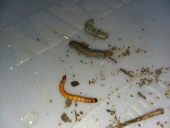Behold the mighty
mealworm! 'Tenebrio molitor' aka Mealworms aka Darkling Beetles present a very unique opportunity to the permaculturist entrepreneur and homesteader.
The bugs are favored by birds (including
chickens, of
course), fish, and reptiles alike as a wonderfully wiggly protein-rich tasty snack. Furthermore, there is a growing market for insects as a crunchy noodly people-food even, for those whose stomachs can actually stomach the thought of eating bugs. Insects' high
feed conversion ratio make them attractive from an environmental and cost perspective.
The Mealworms have yet another super power however, in their ability to consume Styrofoam.
Yes, you read that correctly, these critters actually eat polystyrene.
So in addition to concepts such as those proposed by "
StyrofoamMom", the beetles present a recycling and waste disposal solution or opportunity which helps to actually "obtain a yield."
Our Darkling Diary
Acquiring mealworms:
In late March 2015, my dearest green-thumbed mother, also a backyard bird enthusiastic, purchased 1000 mealworms for ~$10, including a bird feeder, through a promotional deal through
Wild Birds Unlimited. (Btw, did you know you can also purchase bat-house boxes through those stores?) She took the worms out of that refrigerator and into her home and heart, as well as into the
local birds' beaks and bellies. After a quick trip to Bug Lots...*correction,
BIG LOTS discount store...for a small (less than 12" by 6") set of 3 stacking transparent plastic bins, I was able to make a home for these wiggly pioneers.
Simple frass bug bin how-to:
Take a series of plastic stacking bins.Cut out the bottom of most the bins, leaving a ledge around the edge. Reserve one intact bin as the bottom bin to catch frass. Cut a scrap of window screening to size.Apply hot glue to the window screen/box bottom edges.
Feeding and care:
Ensure the bugs have oxygen via mesh screen, but cannot crawl out of their bug bins. Vertical smooth plastic is sufficient. Be aware that any foods or Styrofoam added may shift in the bins, so don't inadvertently let the beetles crawl out by adding too much!The larvae and beetles primary food is originally oatmeal bran.Moisture and nutrients are obtained by the bugs via discarded veggies or fruit scraps (carrot, potato peel, etc)Styrofoam trash can be added in increasing amounts, and will be consumed entirely with no (visible) trace other than normal frass**.Life stages include:
1.
Egg.
2.
Tiny tiny larvae -transitioning to-->
Larger wormy mealworm larvae.
3. Cacoon-like white
Pupae.
4. Lively Darkling
beetle. --> mating, repeat...
Frass is sifted out and used as fertilizer or discarded. Remember that eggs will likely be present in this frass, so be mindful of where frass is disposed.Remove any material that is not consumed or has become moldyPupae can be separated and placed in the upper bins to hatch new beetles.Worms can be fed to critters, or freeze dried, or added to new oatmeal bran filled cups to propagate.
**Note: Frass is mealworm beetle or larvae
poop, a good garden fertilizer. However, latest
research shows that the fire-retardant
HBCD is present in mealworm frass if Styrofoam is consumed (hat tip to Polly for the link). Fortunately, the research is showing that the bugs themselves do not bioaccumulate this specific toxin, and are likely safe for consumption up to the next tropic levels! That said,
the frass must be treated (or disposed of) accordingly due to the toxin HBCD. For more general discussions on polystyrene-eating, check out the
permie posts over
here.
Over the years, my mom's pet bugs and beetles have eaten untold (though very small) amounts of Styrofoam, including trash removed from local wetlands and river waterways.
As of March, 2021, these bugs have reproduced through countless life cycles, with minimal support. They have been forgotten about through several vacations, and yet they persist, +6years later, consuming Styrofoam every year. That said, they are oft forgotten about, and therefore the quantity of beetles has gone down over the years.
Possibilities for research and business-oriented Permies:
Waste removal: How much polystyrene (volume-wise) will they consume?Production analysis: -What mass of bugs can be produced per what unit of bin volume and feed mass?
-What volume of frass is produced?
-How nutritious is the frass for plants?
-How can production be automated?
-Feeding. (Auger?)
-Hydration management. (Basic temperature and humidity sensor?)
-Life cycle management. (Batch selection -> Timing? Light adjustment within the bin to encourage beetles or larvae to move from one specific location to another!? Machine vision, perhaps? Robotic arm to select out largest, most productive worms? Temperature adjustment to pause or slow down life cycle for mealworm harvest?)
-Frass separation and disposal? (Sifting via eccentric weight, motor, and sieves?) from eggs, larvae, pupae, beetles?
Scalability: -How to neutralize polystyrene waste at a larger scale?
-How to propagate and make more worms with the least amount of effort?
-How to safely biodegrade HBCD?
Genetic selection: Can the darkling beetles be bred to maximize polystyrene consumption as well as size?What other waste products are readily consumed by the beetles? (Perhaps spent brewers' grain? Specific types of leaves? Guild selection: Where do mealworms best fit with respect to the larger ecological puzzle? -Inputs/Needs = Containment, Styrofoam, grain, waste veggies, clean air, temperature and light moderation, moisture moderation, waste disposal
-Characteristics: Small; crawling; climbing; burrowing; pupating; mating; egg laying; cannibalism; avoiding light/preference to dark areas; moisture seeking
-Outputs/Yields = Protein for chickens/fish/people; Frass (bioremediate via: time? sunlight? bacteria? mycorestoration?;
CO2 for plants?

 3
3








 1
1




 1
1






















 1
1






 4
4




 4
4

















